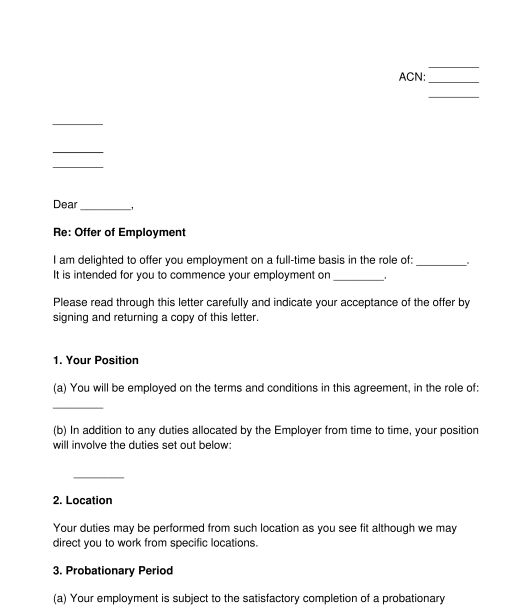 18/09/2025
18/09/2025

Answer a few questions and your document is created automatically.

Your document is ready! You will receive it in Word and PDF formats. You will be able to modify it.

 18/09/2025
18/09/2025
 Word and PDF
Word and PDF
 2 to 3 pages
2 to 3 pages
A Letter of Offer of Employment is a basic, formal job offer template for use when an Australian business is offering a full-time or part-time position to a successful candidate. Usually this Letter of Offer would be sent after successful completion of the interview process by the potential new employee as a way to clarify the terms of the offer of employment and prevent any disputes related to salary, position title, benefits or hours.
This Letter of Offer is suitable for sole-traders, partnerships or companies based anywhere in Australia and records all of the terms required to employ a permanent employee under Australian law.
A Letter of Offer of Employment is similar to an Employment Agreement, but is much more brief.
A Letter of Offer of Employment is designed to be a quick and easy document for employers to send to employees as soon as they are hired. Many employers choose to send a Letter of Offer of Employment and then to follow it up with an Employment Agreement. However, as an Employment Agreement goes into a lot more detail, the employee may need some time to go through it before they sign it, and therefore it is handy to have a basic Letter of Offer of Employment to get the ball rolling.
Some employers, however, find that a Letter of Offer of Employment covers everything that they need, so they do not bother to follow it up with an Employment Agreement. As long as the employer has looked at what is contained in an Employment Agreement, is happy to forego the additional provisions that it contains, (and has taken legal advice if necessary), then there is nothing wrong with this.
Employment in Australia can be on a fixed term or permanent basis:
In addition, whether they are engaged on a fixed term or a permanent basis, employees may also fall into one of the following categories:
No, it is not mandatory. Some businesses just issue an Employment Agreement. But a Letter of Offer of Employment is a great way to get the ball rolling, to communicate with new employees, to welcome them to the business and to demonstrate the professionalism of the business.
It is common in Australia for new employees to be subject to a probationary period of 1-3 months. This period allows the employer to assess whether the new employee is capable of performing the job they have been hired for.
During the probationary period, the employer (and the employee) are able to terminate the employment on 1 week's notice. After the probationary period has expired, more notice is required.
The employee and the employer should sign the Letter of Offer of Employment. The employer could be a company or other business entity (such as a partnership). The employer could even be a sole trader.
The employee should have the lawful right to work in Australia either via their citizenship or a valid work visa.
Each state and territory of Australia has rules about the minimum age for employees. The rules often vary for different industries or categories of work. In many states and territories the minimum age for part time or casual jobs is often quite relaxed. However, there are often more strict rules for full time employees. In most states and territories, employers may also need a Child Employment Permit if they are employing someone under the age of 17.
Once this document has been prepared, it can be signed by the employer and delivered to the employee. The employee can review it and sign it, then give a signed copy to the employer and keep a copy for their records.
After signing a Letter of Offer of Employment, the employer should also:
A Letter of Offer of Employment should include the following details:
This Letter of Offer meets the requirements of the Fair Work Act 2009 (Cth) and addresses the requirements of the National Employment Standards (NES). It is suitable for use throughout all States and Territories of Australia.
You fill out a form. The document is created before your eyes as you respond to the questions.
At the end, you receive it in Word and PDF formats. You can modify it and reuse it.
Guides to help you
Letter of Offer of Employment - sample template
Country: Australia